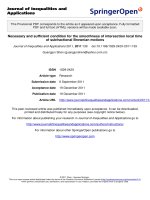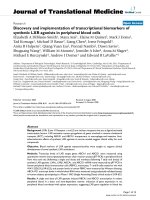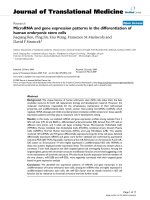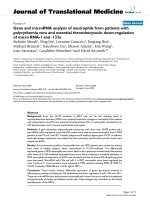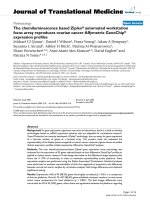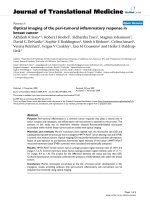Báo cáo hóa học: " LEF-1 and TCF4 expression correlate inversely with survival in colorectal cancer" pptx
Bạn đang xem bản rút gọn của tài liệu. Xem và tải ngay bản đầy đủ của tài liệu tại đây (1.06 MB, 8 trang )
RESEARC H Open Access
LEF-1 and TCF4 expression correlate inversely
with survival in colorectal cancer
Lydia Kriegl
1*
, David Horst
1,3
, Jana A Reiche
1
, Jutta Engel
2
, Thomas Kirchner
1
, Andreas Jung
1
Abstract
Background: Most colorectal carcinomas are driven by an activation of the canonical Wnt signalling pathway,
which promotes the expression of multiple target genes mediating proliferation inavasion and invasion. Upon
activation of the Wnt signalling pathway its key player b-catenin translocates from the cytoplasm to the nucleus
and binds to members of the T-cell factor (TCF)/lymphoid enhancer factor (LEF-1) family namely LEF-1 and TCF4
which are central mediators of transcription. In this study we investigated the expression of b-Catenin, LEF1 and
TCF4 in colorectal carc inomas and their prognostic significance.
Methods: Immunohistochemical ana lyses of LEF-1, TCF4 and nuclear b-Catenin were done using a tissue
microarray with 214 colorectal cancer specimens. Th e expression patterns were compared with each other and the
results were correlated with clinicopathologic variables and overall survival in univariate and multivariate analysis.
Results: LEF-1 expression was found in 56 (26%) and TCF4 expression in 99 (46%) of colorec tal carcinomas and
both were heterogenously distributed throughout the tumours. Comparing LEF-1, TCF4 and b-catenin expression
patterns we found no correlation. In univariate analysis, TCF4 expression turned out to be a negative prognostic
factor being associated with shorter overall surviv al (p = 0.020), whereas LEF-1 expression as well as a LEF-1/TCF4
ratio were positive prognostic factors and correlated with longer overall survival (p = 0.015 respectively p = 0.001).
In multivariate analysis, LEF-1 and TCF4 expression were confirmed to be independent predictors of longer
respectively shorter overall survival, when considered together with tumour sta ge, gender and age (risk ratio for
LEF-1: 2.66; p = 0.027 risk ratio for TCF4: 2.18; p = 0.014).
Conclusions: This study demonstrates different prognostic values of LEF-1 and TCF4 expression in colorectal
cancer patients indicating different regulation of these transcription mediators during tumour progression.
Moreover both factors may serve as new potential predictive markers in low stage colon cancer cases in advance.
Background
Colorectal cancer is one of to the most common tumour
diseases in the Western world but despite significant
improvements in prevention and therapy it is one of the
leading causes of cancer-related death. Dysregulation
and abnormal activation of the Wnt/b-catenin signalling
pathway caused by mutations of APC are decisive for
the initiation as well as progression of colorectal cancer.
Effects of signalling activity of b-catenin are mediated by
members o f the T-cell factor (TCF)/lymphoid enhancer
factor (LEF-1) family. These DNA binding proteins
interact with b-catenin in the nucleus and stimulate a
battery of gene promoters causing pr oliferation, mor-
phogenesis, epithelial-mesen chymal transition and stem-
ness which drive neoplastic progression [1,2]. In the
colorectal adenoma-carcinoma sequence genetic altera-
tions and molecular d ysregulations cause continuous
stabilasation of b-cateninwhich is accompanied partly by
nuclear accumulation of b-catenin in neoplastic cells.
Intratumoral distribution of nuclear b-catenin is thus
hete rogeneous and frequently predomi nates at the inva-
sive front i ndicating an intratumo ural regulation of
Wnt/b-catenin activity and its related effects [3].
Wnt/b-catenin signalling activity and its transcrip-
tional effects might be further modulated by a variable
use of the nuclear binding partner s of b-catenin, namely
TCF4 and LEF-1. TCF4 is the main binding partner of
b-catenin in the colon and mediates transformation of
* Correspondence:
1
Department of Pathology, Ludwig-Maximilians-Universität (LMU),
Thalkirchnerstr. 36, 80337, Munich, Germany
Full list of author information is available at the end of the article
Kriegl et al . Journal of Translational Medicine 2010, 8:123
/>© 2010 Kriegl et al; licensee BioMed Central Ltd. This is an Open Access article distributed under the terms of the Creative Commons
Attribu tion License (h ttp: //creativecommons.org/licenses/by/2.0), which permits unrestr icted use, distribution, and reproduction in
any medium, provided the original work is prope rly cited.
colon epithelial cells upon loss of the tumour-suppressor
protein APC. TCF4 has also been shown to be essential
for the maintenance of the crypt stem cells of gut
epithelium as TCF4 knockout mice show f ew differen-
tiated villi and no proliferating crypt stem cell compart-
ment [4]. LEF-1 on the other hand is a cell type specific
transcription factor which w as initially discovered in
pre-T and B lymphocytes [5-7]. It belongs to the family
of high mobility gro up (HMG) proteins which induce
structural alterations in the DNA-Helix [8,9]. When
overexpressed LEF-1 leads to an enhanced tumour cell
invasiveness [10] and induces epithelial to mesenchymal
transition [11]. Transcription of LEF-1 can be directly
regulated by TCF4-b-catenin complexes [12]. As LEF-1
is not expressed in the normal colon mucosa [13], but is
found in human colorectal cancer [14], a shift of b-cate-
nin binding partners from TCF4 to LEF-1 might occur
during carcinogenesis which might enable enhanced
epithelial-mesenchymal transiti on (EMT) and maligna nt
progression.
As systematic investigations of LEF-1 and TCF4
expression in CRC are lacking up to now, we examined
the intratumoral distribution of TCF4 and LEF-1 in cor-
relation with nuclear b-catenin using immunohisto-
chemistry on tissue microarrays (TMA). Additionally
the results were correlated with clinicopathologic vari-
ables and overall survival in univariate and multivariate
analysis.
Materials and methods
Clinical samples
Colorectal cancer specimens from patients that under-
went intentionally curative surgical resection between
1994 and 2004 at the Ludwig Maximilians-Universität
München were drawn from the Institute’s archives. Only
colorectal adenocarcinomas with mode rate differentia-
tion (G2 according to WHO), T-categories T2 and T3
having neither nodal (N0) nor distant metastasis (M0) at
the time of diagnosis were considered. To reduce sur-
gery related effect, specimens of patients who died
within 6 months after surgical resection were excluded.
This resulted in a collection of tissue from 214 patients,
of whom 105 (49%) died from color ectal cancer within
5 years of diagnosis. The surviv al data of 156 cases
(73%) was cen sored as case follow up was discontinued
or patients died of reasons other than colorectal cancer.
Case characteristics are summarized in Table 1. The
study complied with the requirements of the local ethics
committee.
Tissue microarray technique
Colorectal tissue microarrays (TMA) were constructed
as described previously [15]. Briefly 5 μm sections of
formalin fixed, paraffin embedded tumour samples
stained with haematoxylin-eosin were used to define
representative areas of viable tumour tissue. 1.0 mm
needle core-biopsies were taken from corresponding
areas on the paraffin-embedded tumour blocks using a
tissue arraying instrument (Beecher Instruments, Sun
Prarie, WI, U.S.A) and then placed in recipient paraffin
array blocks at defined coordinates. To ensure that
representative parts of the tumours were investigated six
probes of each tumour were taken - three from central
tumour areas and three from the invasive front. The
cores in the paraffin block were incubated for 30 min at
37°C to improve adhesion between cores and paraffin of
the recipient block.
Immunohistochemistry
Immunohistochemical staining was done on 5 μm sec-
tions of TMA blocks. As primary antib odies, prediluted
anti-b-catenin monoclonal mouse antibody (clone 14,
Ventana Medical Systems), anti-LEF-1 monoclonal rab-
bit antibody (1:150; Cell Signaling Technology, Inc., Cat.
No. 2230S, Boston, UK) and anti-TCF4 monoclonal
mouse antibody (1:50; Zytomed Systems, Cat. No. 120-
0036, Berlin, Germany) were used. Staining of anti-b-
catenin was performed on a Ventana Benchmark XT
autostainer with the XT ultraView DAB Kit (Ventana
Medical Systems). For anti-LEF-1 and a nti-TCF4 the
sections were pre-treated for antigen retrieval by boi ling
in a microwave oven, twice for 15 min at 750 W in Tar-
get Retrieval Solution (Dako, Hamburg, Germany).
Endogenous peroxidase was blocked by incubation in
7.5% hydrogen peroxide for 10 minutes. D etection was
done using Vectastain ABC-Kit Elite Universal kits
(Vector Laboratories, CA, USA) together with AEC
(Zytomed Systems) as the chromogen. Finally, slides
were counterstained with hematoxylin (Vector).
Table 1 Clinicopathological characteristics of the
investigated colorectal cancer cases.
Variable Number of cases %
Gender
Male 116 54
Female 98 46
Age, y
<70 120 56
≥70 94 44
T-category
T2 33 15
T3 181 85
Cancer specific survival, y
<5 105 49
≥5 109 51
Censored 156 73
Kriegl et al . Journal of Translational Medicine 2010, 8:123
/>Page 2 of 8
Evaluation of LEF-1 and TCF4, b-Catenin
immunohistochemistry
Nuclear b-catenin, LEF-1 and TCF4 staining was cate-
gorized as either positive o r negative in tumour cells,
while the intensity of staining was not considered. To
determine the combined influence of LEF-1 and TCF4
on tumorigenesis, a LEF-1/TCF4 score was generated.
Therefore, negative staining of LEF-1 or TCF4 was
scored with 1 and positive staining was scored with 2.
LEF-1 score was then divided by TCF4 score resulting
in values ranging from 0.5 to 2. LEF-1 and TCF 4
expression was moreover found in lymphocytes acting
as the internal positive control. Additionally, LEF-1 and
TCF4 detection was positive in the nucleus of tumour
cells consistent with their function as transcription fac-
tors. Membrano us b-catenin expression was not consid-
ered in the evaluation. To exclude intraobserver
variability specimens were evaluated twice by an obser-
ver who had no prior knowledge of prognosis or other
clinicopathological variables.
Statistical analysis
Cross-tabulations were calculated using Fisher’sexact
test. K aplan-Meier analysis was used to estimate cancer
specific survival. Significance of the Kaplan-Meier statis-
tic was tested by calculating the log-rank. Multivariate
analysis was done recruiting the multivariate Cox regres-
sion model. Statistics were calculated using SPSS version
15.0 (SPSS Inc.). p-values < 0.05 were considered to be
statistically significant.
Results
LEF-1 and TCF4 expression in colorectal cancer
To investigate the localisation of LEF-1 and TCF4 in
human colorectal can cer, we evaluated the expression of
these proteins by imm unostaining on tissue micro arrays.
LEF-1 was found to be positive in 56 cases (26%). 35
tumours displayed LEF-1 positivity both, in the tumour
centre and in the front of invasion, whereas 16 cases
showed LEF-1 staining only in the tumour centre. LEF-1
positivity limited to the front of invasion was found in 5
cases (Figure 1).
TCF4 was found positive in 99 cases (46%). 65
tumours showed TCF4 staining in the tumour cent re
and in the front of invasion. 28 cases exhibited TCF4
positivity only in the tumour centre and 6 cases
showed TCF4 expression limited to t he front of inva-
sion (Figure 2).
Figure 1 LEF-1 expression in human colorectal cancer. 74% of cases displayed no LEF-1 expression, neither in main tumor areas (A) nor in
cells of the invasion front (B). Lymphocytes were LEF-1 positive and served as internal positive control. 26% of cases showed LEF-1 expression
which could be found either only in main tumour areas (C) which occured in 16 cases or only in cells of the invasive front (D) which was seen
in 5 cases or homogenously distributed throughout the tumour which was found in 35 cases. Scale bar 100 μm.
Kriegl et al . Journal of Translational Medicine 2010, 8:123
/>Page 3 of 8
LEF-1 and TCF4 expression in colorectal cancer does not
correlate with b-catenin expression
As LEF-1 and TCF4 were suggested to be important
binding partners of b-c atenin we next evaluated their
expression in relation to n uclear b-catenin . 160 (74%)
cases w ere positive for nuclear b-catenin staining w hile
54 (26%) were negative, which is in accordance to the
literature [16]. 67 (42%) cases displayed nuclear b-cate-
nin expression only in the front of invasion and 93
cases (58%) exhibited nuclear b-catenin positivity both
in the tumour centre and in cells of the front of inva-
sion. The presence and distribution of LEF-1 and TCF4
expression did not corre late with nuclear b-catenin
expression (Table 2).
LEF-1 and TCF4 expression in colorectal cancer correlates
with patient survival
Especially, we were interested to find out if LEF-1 and
TCF4 expression correlates with clinicopathologic
variables and with an overall clinical outcome. When
comparing the LEF-1 and TCF4 status with the clinico-
pathological variables age, gender, and T-category of the
tumour, no correlation was observed a pplying Fisher’s
exact test (Table 3 and 4). In Kaplan-Meier analyses
LEF-1 positivity associated with a significant better 5-
and 10 year survival of patients with colorectal cancer
than LEF-1 negativity (p = 0.015; Figure 3). In contrast
the presence of TCF4 expression was correlated with a
significant worse 5 and 10 year survival compared to its
absence (p = 0.020; Figure 4). Using a LEF-1/TCF4
ratio, we found that a high LEF-1/TCF4 coefficient cor-
related significantly with a better 5- and 10 year survival
(p = 0.001; Figure 5).
In a multivariate Cox regression analysis LEF-1 nega-
tivity indicated an independent relative risk of 2.66 com-
pared to LEF-1 positivity (p = 0.027; Table 5). TCF4
expression represented an independent relative risk of
2.18 when compared to the TCF4 negative group (p =
Figure 2 TCF4 expression in human colorectal cancer. 54% of cases showed no TCF4 expression, neither in main tumour areas (A) nor in
cells of the invasion front (B). 46% of cases showed TCF4 expression which could be found either only in main tumour areas (C) which occurred
in 28 cases or only in cells of the invasive front (D) which was seen in 6 cases or homogenously distributed throughout the tumour which was
found in 65 cases. Scale bar 100 μm.
Table 2 LEF-1 and TCF4 expression are not associated with b-catenin expression
b-Catenin positive cases TCF4 positive TCF4 negative Total b-Catenin negative cases TCF4 positive TCF4 negative Total
LEF-1 positive 19 20 39 LEF-1 positive 8 9 17
LEF-1 negative 55 66 121 LEF-1 negative 17 20 37
Total 74 86 160 Total 25 29 54
Kriegl et al . Journal of Translational Medicine 2010, 8:123
/>Page 4 of 8
0.014; Table 5). Age and gender were not significantly
associated with outcome. Only the T-category - pT3
versus pT2 - was also significant for the outcome in
multivariate analysis (p = 0.049; Table 5).
Discussion
The DNA binding proteins and transcription factors
TCF4 and LEF-1 are partners of nuclear b-catenin and
effectors of the Wnt/b-catenin signalling pathway, which
is decisively involved in tumorigenesis and progression
of colore ctal cancer. TCF4 is present in the base of the
normal colonic crypt where the TCF4/b-catenin com-
plex controls stem cells [17]. In colorectal cancer the
expression of TCF4 as well as LEF-1 has been described
[14,18-20], but was not accurately evaluated and com-
pared with nuclear b-catenin positivity.
The presen t study establishes that the nuclear expres-
sions of TCF4, LEF-1 and b-catenin do not correlate
with each other and that TCF4 and LEF-1 positivity is
not mutually exclusive in colorectal cancer. In accor-
dance with published literature we found nuclear b-cate-
nin positivity in 75% of cases. In contrast LEF-1
expression was found only in 26% and TCF4 in 46% of
colorectal carcinomas. Comparing LEF-1, TCF4 and b-
catenin expression, there were cases without nuclear b-
catenin which were positive for LEF-1, TCF4 or bo th
factors. Additionally, other cases showed b-catenin posi-
tivity, but lacked LEF-1 and TCF4 expression. These
findings suggest that activation of the Wnt signalling
pathway as indicated by the presence of nuclear b-cate-
nin staining, is not necessaril y accompanied by TCF4 or
LEF-1 expression. Furthermore, TCF4 a nd LEF-1
Table 3 LEF-1 expression does not correlate with age,
gender or T-category of the investigated colorectal
cancer cases
Variable LEF-1 positive LEF-1 negative p
Gender
Male 30 86 0.52
Female 26 72
Age, y
<70 35 85 0.16
≥70 21 73
T-category
T2 20 13
T3 43 138 0.14
Table 4 TCF4 expression does not correlate with age,
gender or T-category of the investigated colorectal
cancer cases
Variable TCF4 positive TCF4 negative p
Gender
Male 58 58 0.15
Female 41 57
Age, y
<70 55 65 0.50
≥70 44 50
T-category
T2 19 14
T3 80 101 0.24
Figure 3 LEF-1 expression correlates with good survival.
Kaplan-Meier plot of colorectal cancer specimens (n = 214)
demonstrates significant (log-rank test) better survival with LEF-1
expression (p = 0.015).
Figure 4 TCF4 expression correlates with low survival.Kaplan-
Meier plot of colorectal cancer specimens (n = 214) demonstrates
significant (log-rank test) worse survival with TCF4 expression (p =
0.020).
Kriegl et al . Journal of Translational Medicine 2010, 8:123
/>Page 5 of 8
positivity is not restricted to b-catenin positive cases
implicati ng the presence of Wnt-signalling-inde pendent
mechanisms, which can additionally regulate the expres-
sion of both factors in vivo.
As LEF-1 has been shown to be a target of TCF4/b-
catenin [14], we speculated that tumour progression
may be accompanied by a shift of b-catenin binding
partners from TCF4 to LEF1 and we therefore expected
to find TCF4 positivity mainly in central tumour areas
and LEF-1 mainly in the front of invasion. This
assumption seemed to be in accordanc e with studies
showing that LEF-1 enhances tumour cell invasiveness
[10] and induces an epithelial to mesenchymal transition
[11]. However in most tumours the expression of these
factors was heterogeneously distributed throughout the
tumours without a discernable expression pattern.
Furthermore when correlating both factors with survival
we found that only TCF4 expression was associated
with a significant lower overall survival, which fits with
the continuous activatio n of the Wnt/b-catenin signal-
ling pathway in colore ctal tumorigenesis and malignant
tumour progression [1,21] . In contrast LEF-1 expression
and the LEF-1/TFC4 coefficient correlated with a signifi-
cant better overall su rvival. These surprising findings
suggest that TCF4 might be the main binding partner
for b-catenin during development and progression of
colorectal cancer whereas an enhancement of Wnt/b-
catenin transcriptional activity by a switch from TCF4
to LEF-1 is unlikely. Moreover, LEF-1 expression is
independent from the TCF4/b-catenin expression.
In fact, LEF-1 expression has been shown to be inde-
pendently of the canonical Wnt signalling activated by
the TGF-b/Smad signalling pathway [22]. Inhibition of
TGFb signalling plays a role in tumour progression of
colorectal cancer [23,24] and inactivating mutations of
the TGFb pathway have been shown to cause an induc-
tion of growth arrest, differentiation and apoptosis being
crucial events during the cancer progression [2,25,26].
Loss of TGF-b responsiveness promotes tumour pro-
gression in human colorectal cancers [27] and overex-
pression of the TGFb inhibitor BAMBI causes colon
cancer cells to form tumours that metastasize more fre-
quently to liver and lymph nodes than control cancer
cells in mural models [28]. In our study LEF-1 expres-
sion in colorectal cancer correlated with an improved
patient survival. Therefore LEF-1 expression might indi-
cate an activated TGFb signalling which reduces tumour
progression and development of metastasis.
TCF4 and LEF-1 expression was found to be heteroge-
neously distributed throughout the tumours, which is in
support with the fact that individual tumours are orga-
nized hierarchically. Tumors display distinct sub-areas
of proliferation, cell-cycle arrest, epithelial d ifferentia-
tion, cell adhesion and dissemination and contain differ-
ent cell sup-populations like more differentiated tumor
cells and tumorigenic cancer stem-like cells (CSC).
CSCs are characterized by an activated Wnt/b-catenin
signalling pathway [29] which is indicated by the nuclear
expression of b-ca tenin, and EMT [30]. Dedifferentiated
tumor cells with signs of EMT and nuclear expression
of b-catenin which might be CSCs are foun d at the
invasion front of colorectal cancers [31]. As LEF1
expression was found mo re often in main tumour areas
and correlated with better survival it might indicate
Figure 5 LEF-1/TCF4 coefficient correlates with good surviva l.
Kaplan-Meier plot of colorectal cancer specimens (n = 214)
demonstrates significant (log-rank test) better survival with high
LEF-1/TCF4 ratio (p = 0.001).
Table 5 Multivariate survival analysis.
Variable Relative risk
(95% confidence interval)
p
LEF-1
Positive 1.00
Negative 2.66 (1.11–6.34) 0.027
TCF4
Negative 1.00
Positive 2.18 (1.17–4.06) 0.014
Gender
Male 1.00
Female 0.98 (0.53–1.81) 0.948
Age, y
<70 1.00
≥70 1.67 (0.91–3.07) 0.100
T-category
T2 1.00
T3 2.19 (1.28–6.28) 0.049
LEF-1 and TCF4 expressions in colorectal carcinoma are independent marker
for patient survival.
Kriegl et al . Journal of Translational Medicine 2010, 8:123
/>Page 6 of 8
differentiated tumor cells without invasive or metastatic
potential. In contrast TCF4 expression might indicate
cellswithtraitsofCSCsconsistentwithitsfunctionto
maintain crypt stem cells of gut epithelium and its cor-
relation with lower survival.
Conclusions
In summary, we found LEF-1 expression in 26% a nd
TCF4 in 46% of colorectal tumours. Both transcription
factors were found mainly to be heterogeneously distrib-
uted throughout the tumours with expression of LEF-1
and TCF4 in cells of the invasive front in the majority
of cases. Expression of LEF-1 and TCF4 did not corre-
late with each other or with b-catenin distribution.
Furthermore we obtained evidence for a role of LEF-1
and TCF4 as independent prognostic variables of clinical
outcome in colorectal tumour patients. LEF-1 expres-
sion correlated with a lower risk of death of disease and
TCF4 expression correlated with a higher risk of death
of disease. These results indicate different effects of the
Wnt signalling pathway in vivo depending upon the
nuclear binding partners of b-catenin. Moreover bot h
factors may serve as new po tential predictive markers in
low stage colon cancer cases in advance.
List of abbreviations
CSC: cancer stem cell; EMT: epithelial-mesenchymal transition; LEF-1:
lymphoid enhancer factor 1; mRNA: messenger ribonuclein acid; TCF: T-cell
factor; TMA: tissue microarray
Acknowledgements
We thank A Sendelhofert, A Heier, H Prelle, S.Liebmann and G Janssen for
their expert support and experimental assistance. This study was supported
in part by the K. L. Weigand’schen Stiftung, Germany (2005, support to LK
and AJ) and DFG (JU 368-4-1 to AJ and TK).
Author details
1
Department of Pathology, Ludwig-Maximilians-Universität (LMU),
Thalkirchnerstr. 36, 80337, Munich, Germany.
2
Munich Cancer Registry (MCR)
of the Munich Cancer Centre (MCC) at the Department of Medical
Informatics, Biometry and Epidemiology, Ludwig-Maximilians-Universität
(LMU), University Hospital Großhadern, Marchioninistraße 15, 81377 Munich,
Germany.
3
Dana-Farber Cancer Institute, Boston, USA.
Authors’ contributions
LK conceived the study design, carried out and coordinated
immunohistochemical examinations of tumor specimens and data analysis,
and drafted the manuscript. DH participated in the interpretation of data
and conducted immunohistochemistry analysis. JE collected the clinical data
of patients and performed statistical data analysis. AJ and TK coordinated
the study and were involved in drafting the manuscript and revised it
critically. All authors read and approved the final manuscript.
Competing interests
The authors declare that they have no competing interests.
Received: 19 February 2010 Accepted: 22 November 2010
Published: 22 November 2010
References
1. Vogelstein B, Fearon ER, Hamilton SR, Kern SE, Preisinger AC, Leppert M,
Nakamura Y, White R, Smits AM, Bos JL: Genetic alterations during
colorectal-tumor development. N Engl J Med 1988, 319:525-532.
2. van de Wetering M, Sancho E, Verweij C, de Lau W, Oving I, Hurlstone A,
van der Horn K, Batlle E, Coudreuse D, Haramis AP, et al: The beta-catenin/
TCF-4 complex imposes a crypt progenitor phenotype on colorectal
cancer cells. Cell 2002, 111:241-250.
3. Brabletz T, Jung A, Hermann K, Gunther K, Hohenberger W, Kirchner T:
Nuclear overexpression of the oncoprotein beta-catenin in colorectal
cancer is localized predominantly at the invasion front. Pathol Res Pract
1998, 194:701-704.
4. Korinek V, Barker N, Moerer P, van Donselaar E, Huls G, Peters PJ, Clevers H:
Depletion of epithelial stem-cell compartments in the small intestine of
mice lacking Tcf-4. Nat Genet 1998, 19:379-383.
5. Waterman ML, Fischer WH, Jones KA: A thymus-specific member of the
HMG protein family regulates the human T cell receptor C alpha
enhancer. Genes Dev 1991, 5:656-669.
6. Travis A, Amsterdam A, Belanger C, Grosschedl R: LEF-1, a gene encoding
a lymphoid-specific protein with an HMG domain, regulates T-cell
receptor alpha enhancer function [corrected]. Genes Dev 1991, 5:880-894.
7. van de Wetering M, Oosterwegel M, Dooijes D, Clevers H: Identification
and cloning of TCF-1, a T lymphocyte-specific transcription factor
containing a sequence-specific HMG box. Embo J 1991, 10:123-132.
8. Giese K, Cox J, Grosschedl R: The HMG domain of lymphoid enhancer
factor 1 bends DNA and facilitates assembly of functional nucleoprotein
structures. Cell 1992, 69:185-195.
9. Love JJ, Li X, Case DA, Giese K, Grosschedl R, Wright PE: Structural basis for
DNA bending by the architectural transcription factor LEF-1. Nature 1995,
376:791-795.
10. Nguyen A, Rosner A, Milovanovic T, Hope C, Planutis K, Saha B, Chaiwun B,
Lin F, Imam SA, Marsh JL, Holcombe RF: Wnt pathway component LEF1
mediates tumor cell invasion and is expressed in human and murine
breast cancers lacking ErbB2 (her-2/neu) overexpression. Int J Oncol
2005, 27:949-956.
11. Kim K, Lu Z, Hay ED: Direct evidence for a role of beta-catenin/LEF-1
signaling pathway in induction of EMT. Cell Biol Int 2002, 26:463-476.
12. Li TW, Ting JH, Yokoyama NN, Bernstein A, van de Wetering M,
Waterman ML: Wnt activation and alternative promoter repression of
LEF1 in colon cancer. Mol Cell Biol 2006, 26:5284-5299.
13. van Genderen C, Okamura RM, Farinas I, Quo RG, Parslow TG, Bruhn L,
Grosschedl R: Development of several organs that require inductive
epithelial-mesenchymal interactions is impaired in LEF-1-deficient mice.
Genes Dev 1994, 8:2691-2703.
14. Hovanes K, Li TW, Munguia JE, Truong T, Milovanovic T, Lawrence Marsh J,
Holcombe RF, Waterman ML: Beta-catenin-sensitive isoforms of lymphoid
enhancer factor-1 are selectively expressed in colon cancer.
Nat Genet
2001, 28:53-57.
15. Kononen J, Bubendorf L, Kallioniemi A, Barlund M, Schraml P, Leighton S,
Torhorst J, Mihatsch MJ, Sauter G, Kallioniemi OP: Tissue microarrays for
high-throughput molecular profiling of tumor specimens. Nat Med 1998,
4:844-847.
16. Horst D, Reu S, Kriegl L, Engel J, Kirchner T, Jung A: The intratumoral
distribution of nuclear beta-catenin is a prognostic marker in colon
cancer. Cancer 2009, 115:2063-2070.
17. Barker N, Huls G, Korinek V, Clevers H: Restricted high level expression of
Tcf-4 protein in intestinal and mammary gland epithelium. Am J Pathol
1999, 154:29-35.
18. Reya T, Clevers H: Wnt signalling in stem cells and cancer. Nature 2005,
434:843-850.
19. Moon RT, Kohn AD, De Ferrari GV, Kaykas A: WNT and beta-catenin
signalling: diseases and therapies. Nat Rev Genet 2004, 5:691-701.
20. Logan CY, Nusse R: The Wnt signaling pathway in development and
disease. Annu Rev Cell Dev Biol 2004, 20:781-810.
21. Vincan E, Barker N: The upstream components of the Wnt signalling
pathway in the dynamic EMT and MET associated with colorectal cancer
progression. Clin Exp Metastasis 2008, 25:657-663.
22. Nawshad A, Hay ED: TGFbeta3 signaling activates transcription of the
LEF1 gene to induce epithelial mesenchymal transformation during
mouse palate development. J Cell Biol 2003, 163:1291-1301.
Kriegl et al . Journal of Translational Medicine 2010, 8:123
/>Page 7 of 8
23. Ba Y, Tonoki H, Tada M, Nakata D, Hamada J, Moriuchi T: Transcriptional
slippage of p53 gene enhanced by cellular damage in rat liver:
monitoring the slippage by a yeast functional assay. Mutat Res 2000,
447:209-220.
24. Benson KF, Person RE, Li FQ, Williams K, Horwitz M: Paradoxical
homozygous expression from heterozygotes and heterozygous
expression from homozygotes as a consequence of transcriptional
infidelity through a polyadenine tract in the AP3B1 gene responsible for
canine cyclic neutropenia. Nucleic Acids Res 2004, 32:6327-6333.
25. Li F, Cao Y, Townsend CM Jr, Ko TC: TGF-beta signaling in colon cancer
cells. World J Surg 2005, 29:306-311.
26. Wang J, Yang L, Yang J, Kuropatwinski K, Wang W, Liu XQ, Hauser J,
Brattain MG: Transforming growth factor beta induces apoptosis through
repressing the phosphoinositide 3-kinase/AKT/survivin pathway in colon
cancer cells. Cancer Res 2008, 68:3152-3160.
27. Tang B, Vu M, Booker T, Santner SJ, Miller FR, Anver MR, Wakefield LM: TGF-
beta switches from tumor suppressor to prometastatic factor in a model
of breast cancer progression. J Clin Invest 2003, 112:1116-1124.
28. Fritzmann J, Morkel M, Besser D, Budczies J, Kosel F, Brembeck FH, Stein U,
Fichtner I, Schlag PM, Birchmeier W: A colorectal cancer expression profile
that includes transforming growth factor beta inhibitor BAMBI predicts
metastatic potential. Gastroenterology 2009, 137:165-175.
29. Vermeulen L, De Sousa EMF, van der Heijden M, Cameron K, de Jong JH,
Borovski T, Tuynman JB, Todaro M, Merz C, Rodermond H, et al: Wnt
activity defines colon cancer stem cells and is regulated by the
microenvironment. Nat Cell Biol 12:468-476.
30. Mani SA, Guo W, Liao MJ, Eaton EN, Ayyanan A, Zhou AY, Brooks M,
Reinhard F, Zhang CC, Shipitsin M, et al: The epithelial-mesenchymal
transition generates cells with properties of stem cells. Cell 2008,
133:704-715.
31. Brabletz T, Jung A, Reu S, Porzner M, Hlubek F, Kunz-Schughart LA,
Knuechel R, Kirchner T: Variable beta-catenin expression in colorectal
cancers indicates tumor progression driven by the tumor environment.
Proc Natl Acad Sci USA 2001, 98:10356-10361.
doi:10.1186/1479-5876-8-123
Cite this article as: Kriegl et al.: LEF-1 and TCF4 expression correlate
inversely with survival in colorectal cancer. Journal of Translational
Medicine 2010 8:123.
Submit your next manuscript to BioMed Central
and take full advantage of:
• Convenient online submission
• Thorough peer review
• No space constraints or color figure charges
• Immediate publication on acceptance
• Inclusion in PubMed, CAS, Scopus and Google Scholar
• Research which is freely available for redistribution
Submit your manuscript at
www.biomedcentral.com/submit
Kriegl et al . Journal of Translational Medicine 2010, 8:123
/>Page 8 of 8
